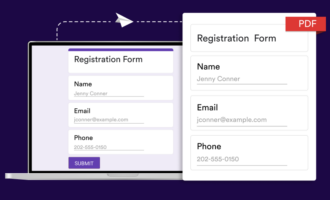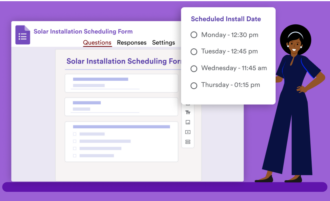Creating a Google Form for BMI calculation
- Create an intake and assessment form with Google Forms
- Link form submissions to a Google Sheet
- Establish the BMI calculator
In recent years, online form builders have become indispensable ways for dieticians and other health practitioners to save time and streamline patient intake and assessment processes. These platforms allow healthcare professionals to efficiently collect vital patient information, dietary preferences, medical history, and more, all in a secure and accessible online format. And now they can even automate body mass index (BMI) calculations.
With Google Forms, automating BMI calculation is easy, as long as you follow all the necessary steps. This guide will walk you through how to set up your Google Form for BMI calculations, and it offers an alternative form-building solution that can make automatic BMI calculation even simpler.
Pro Tip
Check out how to add calculated fields in Google Forms to learn more about the calculation features offered by Google Forms..

Looking for the best alternative to Google Forms?
Jotform’s full-featured form-building solution is mobile-friendly and has the most integrations in the industry. Use it to collect payments, automate workflows, gather leads, and more.
How to set up a Google Form for BMI calculation
With Google Forms, you can automatically calculate a patient’s BMI based on information they enter on your intake and assessment form. You’ll just have to create a simple Google Form and do some light coding on the Google Sheet that collects your form responses. Here’s how to set up a Google Form for BMI calculation.
Part 1: Create an intake and assessment form with Google Forms
- Go to forms.google.com and sign in with your Google account if you aren’t already logged in.
- Click the + Blank button to create a new form.
- Customize your form to include the necessary questions, such as the patient’s name, contact details, and other critical data. Make sure to include questions asking about their height, weight, gender, and age.
Note: For BMI, you only need the patient’s height and weight. However, for the BMI calculations in your Google Sheet to work, patients must report their weight in pounds (lbs) and their height in total inches (rather than in the feet and inches format), so make sure to include those instructions in your form.
Part 2: Link form submissions to a Google Sheet
- Once you’ve customized your form to your liking, click the Responses tab.
- Click the View in Sheets button at the top right to create a new Google Sheet linked to the form or to view the spreadsheet that’s already been linked.
Part 3: Establish the BMI calculator
- Select the empty column where you’d like to calculate BMI for each form submission.
- Title the column (e.g., “BMI”).
- In the first row of the BMI column, type the formula to calculate the patient’s BMI. The formula for calculating BMI in the U.S. imperial measurement system is BMI = weight (lb) / [height (in)]2 x 703.
- Automatically calculate BMI by populating this formula with cell references specific to each row. For example, if the first line of data is Row 1, the weight column is B, and the height column is C, write the formula like this: =B1/(C1)^2*703.
- Drag the formula down to apply it to all the data rows. That way, it will automatically calculate the BMI for each person who submits the form.
With this formula in place, you can easily access the baseline BMI of every new patient for reference when making your assessments.
Why Jotform is a great alternative to Google Forms for BMI calculations
While Google is a great solution for dieticians and health professionals who want to make convenient digital forms for their patients, using Google Forms for BMI calculation leaves a lot to be desired. Fortunately, Google Forms is far from the only option on the market.
Jotform is another free online form builder with more than 10,000 customizable templates to build from, making it an excellent alternative to Google Forms. With its user-friendly interface and extensive range of customization options, Jotform empowers users to create stunning, professional-looking forms effortlessly.
With Jotform’s BMI Calculator Widget, users can easily calculate their BMI within the form itself. To enable this, just drag and drop the widget into your form — no coding necessary. All submissions automatically record in Jotform Tables, and the platform’s additional features can enable even more automations.
What’s more, the widget allows respondents to input their height in the standard feet and inches format they’re used to, with no need to convert into total inches. This is both more convenient for new patients and more accurate for health professionals gathering BMI recordings, since it standardizes calculations.
How to create a BMI calculator with Jotform
Thanks to Jotform’s advanced functionality, dieticians and other health professionals can automate BMI calculations much more easily than using Google Forms. Here’s what to do:
- Go to the Jotform Form Builder.
- Open the form you’d like to add the BMI Calculator Widget to, or create a new form and design it according to your needs.
- Click the Add Form Element + button on the left side.
- Click the Widgets tab.
- Scroll down or search for BMI Calculator in the widget menu.
- Click and hold the BMI Calculator Widget, drag it into the form builder window, and drop it where you want it to appear in your form.
- Customize the BMI Calculator Widget to your needs and click Update Widget to save changes.
It’s that easy to build a robust BMI calculator in Jotform.
Knowing BMI is crucial for both patients and health practitioners in assessing overall health, understanding diet needs, and setting health and fitness goals. Automating BMI calculation helps patients better understand and track their own health, and it saves time and energy for providers so they can focus instead on patient communication.
Using Google Forms for BMI is a great way to get more out of the Google product suite you’re already using, but it’s more complex to set up than necessary. If you want a convenient and polished experience for new patient assessments, Jotform has all of the features needed to make it happen — code-free.
Photo by Dominika Roseclay






































































































Send Comment: